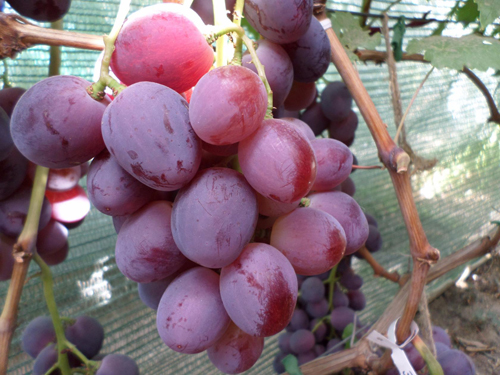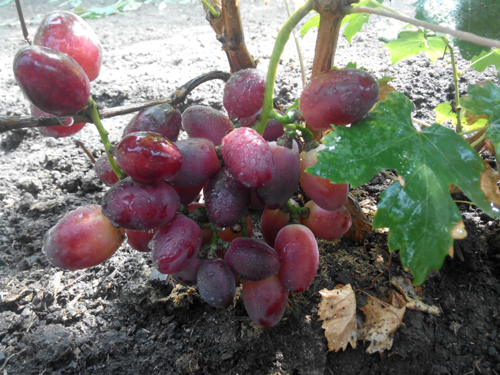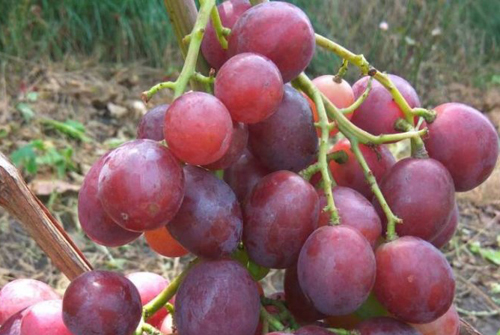Everest grape variety
Everest is one of the newest hybrid forms of grapes from the recognized national master of folk selection Yevgeny Pavlovsky. The novelty was born just a few years ago, as a result of hybridization of the famous variety Mascot, widely used by amateur breeders because of the easy-to-use, functionally feminine type of flower, and Cardinal resistant, also known as K-81. At the first stages of work with hybrid offspring, the seedling, which was then allocated to a new form, was assigned the B-12-1 code, which later became a synonym for the official name.

The variety is characterized by a remarkable large-fruited inherited from both parents. In addition, the attractive color of the berries, clearly borrowed from the Cardinal, provides an excellent presentation. The bushes themselves are characterized by high vitality and potentially high yields. But the resistance of grapes to disease and frost is still being tested.
Despite the recent appearance of Everest on the market, many growers have already become interested in it, expanding the geography of its distribution every year. These pioneers are also the variety testers of the novelty. Already their first reviews inspire optimism and confidence that a promising variety awaits a great future, and the army of its fans will only grow.
Agrobiological characteristics
Plants from the first years of life demonstrate active and strong vine growth. The crown of a young shoot is open, shiny, without pubescence, of a pale green color with some hint of anthocyanin pigmentation of young leaves and the axis of the shoot. Full leaves are very beautiful, delicate, heart-shaped, medium-sized, consist of five lobes, strongly dissected among themselves. The surface of the grape leaf is reticulate and wrinkled, the color is deep green. The profile of the leaf blade is flat. The upper lateral notches are very deep, predominantly closed with an ovoid lumen. The lower notches are slightly shallower in depth, mostly open, lyre-shaped with a rounded bottom. The petiolate notch is open, vaulted, but lyre-shaped, with a sharp bottom is also possible. Petioles are of medium length, green, often with a reddish base. The lateral teeth are large, elongated, characterized by smooth edges and sharp tops. The flowers are bisexual, due to which fertilization occurs efficiently and fully, the vast majority of berries acquire the sizes typical for the variety and do not have peas. The ripening of the Everest vine is full and high-quality, occurs along the entire length of the shoot.

Bunches of grapes grow large and very large. Their average weight is 800-900 grams, but many significantly exceed a kilogram weight. The shape of the mature brushes is conical or cylindrical-conical. The density is low, due to which the grapes are not squeezed in bunches and do not deform. The comb is greenish-red, herbaceous, but at the same time thick and powerful, it can easily support the weight of even the most massive fruits. The berries are oval, excellent in size, although not always well aligned within the bunch. Their weight ranges from 15 to 20 grams, some up to 25 grams. The pulp is dense, juicy-fleshy, with a pleasant and harmonious taste, but, unfortunately, without the nutmeg aroma so beloved by many winegrowers. The juice is colorless, its sugar content reaches 20 g / 100 ml. There is no data on acid content, but judging by the balanced taste, there is no reason to worry about excessive acidity of the bases. The skin is of medium thickness, dense, while being eaten, is painted on the outside in a dark red color, and on the sunny side the color is often less intense than on the shady side. The surface of the skin is covered with a clearly visible layer of protective pruin plaque.The seeds are not too large, light in color, small voids can form around the seeds, which, however, does not have a particular effect on the gastronomic qualities of the grapes. The tasting marks shown by the variety are consistently high.
This makes the crop ideal for fresh consumption. It also enjoys success in the market, since in addition to its excellent taste, it has a high presentation of the bunches. Large, attractively colored berries stand out favorably on the counter and invariably arouse the interest of buyers. Thus, the hybrid may be of interest to commercial farmers. It will also be important for them that Everest is able to carry transportation over long distances without damage. On personal plots, our hero will also look very dignified, and is quite capable of becoming one of those varieties that bring only positive emotions and a sense of satisfaction to the owners. Here, in addition to being eaten fresh, it will be useful for preparing a variety of homemade preserves, to which it will convey its rich color and excellent taste. The first reviews also speak about the possibility of long-term storage of fresh grapes.

The novelty belongs to varieties with an early ripening period. The bunches reach removable maturity after 115-120 days from the moment the buds open. Such a short growing season is reflected in the amount of heat required by the plants to achieve the desired harvest conditions. The required sum of active temperatures is 2300-2400 ° C, and characterizes the hybrid as capable of productive growth significantly north of the traditional grape growing zones. Varieties with a similar growing season are currently growing well and bearing fruit even in the suburbs, and therefore Everest may well compete with them. For regions that are harsh in terms of climatic conditions, it is only necessary to provide for the possibility of reliable warming of the vine for the winter, since it is not necessary to count on the very high frost resistance of the novelty.
Bushes, which have already entered full fruiting among many growers, show good yield indicators due to the rather high fruitfulness of the shoots, excellent vitality of plants and, of course, remarkable large-fruited. They "stretch" 15-20 kilograms of grapes without any problems and delays in the growing season. For larger volumes, it is necessary to take additional measures to care for plants, primarily in terms of moisture and mineral nutrition. If these needs are ignored, then overloading can turn into negative consequences in the form of a decrease in the growth and ripeness of shoots, a shift in the timing of the onset of ripeness, the appearance of wateriness, and a deterioration in the taste of berries.
After reaching the parameters of removable (or as it is also called - technical) maturity, the grapes can continue to be on the bushes, ripening completely. During this time, the maximum possible number of sugars and aromatic substances accumulates in the bunches, and the proportion of acids decreases. An obstacle to this may be the predisposition of a particular variety to rotting or cracking of berries, but our hero, fortunately, does not sin at all. And even wasps, which are often the scourge of table varieties, do not do much harm to Everest.
Agrotechnical features
Despite the not yet fully studied characteristics of the hybrid, it is already possible to state with confidence that its cultivation will not be difficult. It does not relate to the pampered and capricious varieties for sure.
For planting grapes, it is advisable to choose areas with fertile soil, sufficient moisture supply, but at the same time not damp and not swampy. Also, places with a close occurrence of groundwater to the surface are not suitable.Critical values of heat supply can be typical only for the most northern regions. Here, in order to increase the SAT level, it is recommended to place vineyards exclusively on the southern slopes, and on summer cottages, orchards and backyards in a wall culture on the southern side of various buildings under the protection of plants from cold winds.
The variety is easily propagated by rooted seedlings, but such a method is possible only in areas free from the malicious soil pest - phylloxera. In traditional zones of industrial viticulture, where root aphids are very widespread, Everest is planted with seedlings grafted onto special rootstocks, which phylloxera does not harm. Vigorous grape bushes are placed at a sufficient distance from each other.
Due to the not yet established frost resistance, as well as the shortage and natural high cost of planting material, winegrowers prefer to cultivate the new product, covering it for the winter. To do this, they form bushes according to the principle of a multi-arm fan or an oblique cordon, so that they can be removed from the trellis without much difficulty and damage to the vine, and returned to its place in the spring. The type and intensity of the shelter differs depending on the frost hazard of the climate: from a light earthy one in the south to a powerful multilayer one in the regions with severe winters. For inquisitive minds cultivating a hybrid in relatively warm regions, it is advisable to try breeding a semi-covering formation on one or more bushes. This will allow, without the risk of plant death, to independently determine the frost resistance of the variety and the ability of grapes to grow uncovered in a particular area.
The entry of Everest into fruiting occurs 2−3 years, depending on the method of reproduction: in self-rooted bushes earlier, grafted - later. With its onset, they switch from formative pruning to annual pruning, aimed at obtaining a high yield, but also avoiding overloading plants with it. In the first seasons, the load is gradually increased, bringing it to the standard one by 4-5 years after planting. The average pruning length is used - for 8-10 eyes, and 30-40 buds are left on the bush as a whole. Developed sterile and weak shoots of grapes break off, and on fruit-bearing ones, extra inflorescences are removed, leaving one, the largest, for the shoot.
To combat fungal diseases in the absence of information about the resistance of Everest to them, it is possible to advise to carry out mandatory comprehensive preventive spraying before and after the flowering of the variety, and during the subsequent stages of the growing season to closely monitor the state of the vineyard. In the event of the appearance of foci of pathogen development, take immediate measures to eradicate them.








